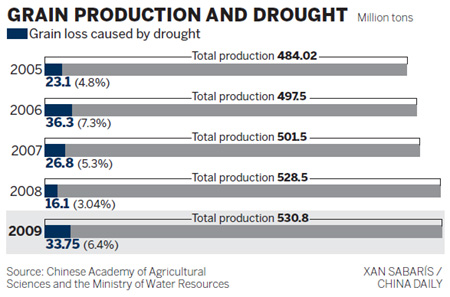-
News >Bizchina
Drought 'poses threat' to grain security
2011-02-18 15:34
Increasing frequency and severity hit supply: experts
BEIJING - The frequency and severity of droughts have increased over the past decade, causing heavy crop losses and posing a potentially grave threat to grain security, leading agriculture experts warn.
"Catastrophic drought occurred once every five years in the 1950s and once every two years in the 1990s. But in the past 10 years it's been almost every year," Li Maosong, director of the Agricultural Information Office at the Chinese Academy of Agricultural Sciences (CAAS), told China Daily.
The continuing dry spell in northern China's wheat heartland has caused considerable international concern, and sparked a warning from the United Nations last week about the possible loss of winter crops, a key harvest for the world's biggest grain producer.
Drought conditions are currently prevailing in North China and have exacerbated a water shortage in South China.
Li said droughts cause more grain loss than any other natural disaster.
"Nearly 60 percent of the grain loss is caused by drought. The other main causes of crop loss are flood, plant diseases and insects," Li said.
The amount of arable land affected by natural disasters has increased by nearly 5 million hectares in the past decade, according to CAAS statistics.
To feed its rising population, China plans to boost grain output to more than 550 million tons annually by 2020.
Grain output was 546 million tons in 2010, compared to 430 million tons in 2003, according to the Ministry of Agriculture.
But agriculture experts warn that the future grain crop could be endangered if natural disasters increase in frequency.
From 2003 to 2009, total grain loss from various natural disasters reached 303.35 million tons - more than four times the increase in output over the same period, CAAS statistics showed. Grain loss caused solely by drought during this period was 185.38 million tons, according to statistics from the Ministry of Water Resources.
"Therefore, reducing grain loss caused by natural disasters, especially drought, is as important as increasing output," Li said.
A five-year program has been launched by the Ministry of Science and Technology this year to protect crops, he said.
The program will be introduced in 500,000 hectares of farmland and includes planting disaster-resistant crops in a bid to reduce losses by 10 percent.
But Wang Chunyan, a CAAS researcher, said China has yet to draft an overall drought plan.
For instance, irrigation facilities have yet to be improved in the middle and lower reaches of the Yangtze River, a task that is becoming increasingly urgent, she said.
Drought has so far affected 6.7 million hectares of winter wheat farmland in eight provinces including Hebei, Henan, Shanxi, Jiangsu and Anhui, which account for nearly 40 percent of their wheat-sown areas, according to the latest statistics from the Ministry of Agriculture.
Although light snow fell last week, experts said more precipitation is needed.
The central government has said it will spend $1 billion to alleviate conditions.
Although some analysts speculate that the country would be forced to import wheat to meet domestic demand, Foreign Ministry spokesman Ma Zhaoxu said on Tuesday that the country has plentiful reserves and the drought will not affect global food prices.Nie Zhenbang, director of the State Administration of Grain, also expressed assurances that China's grain supply can meet demand, according to a report posted on the official website of the administration, chinagrain.gov.cn.
The report quoted Nie as saying that the total global grain trade amounts to 40 percent of China's annual consumption and with tightening supplies in the world market, large-scale imports to meet domestic needs are "unrealistic".
"So China should rely on its own domestic production," Nie said.
